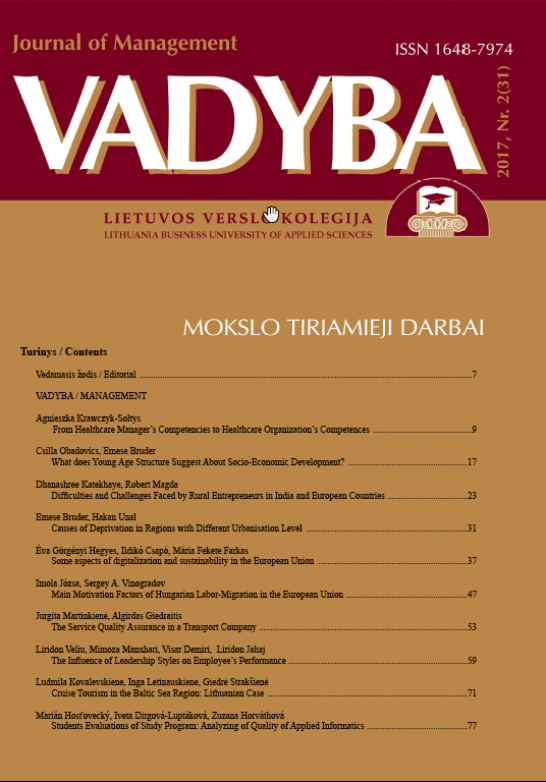WHAT DOES YOUNG AGE STRUCTURE SUGGEST ABOUT SOCIO-ECONOMIC DEVELOPMENT?
WHAT DOES YOUNG AGE STRUCTURE SUGGEST ABOUT SOCIO-ECONOMIC DEVELOPMENT?
Author(s): Csilla Obadovics, Emese BruderSubject(s): Social development, Demography and human biology, Economic development, Migration Studies, Socio-Economic Research
Published by: Lietuvos verslo kolegija
Keywords: ageing, migration; depopulation; socio-economic inequalities;
Summary/Abstract: Socio-economic development and the age structure of a population are often linked together in the public discourse. The development of an area and its age structure are significantly correlated in Europe according to researchers. In this paper we take a look behind this simplifications, providing insights about the link between age structure and the development of the area. Our hypothesis is, that favourable age structure does not necessarily mean a higher socio-economic situation. Henceforward we argue, that migration is one of the most significant indicators of regional socio-economic inequalities. However, the situation needs a deeper understanding. One part of the less favourable areas is characterised by an ageing population and out-migration, but in the other part we can experience the opposite. The statement that in the less developed areas we can only find ageing populations without young inhabitants, while in the developed areas we can find the opposite, is not true in Hungary. The study examines and compares the socio-economic situation in less favourable rural areas of Hungary where the less favoured situation can be found together with an unfavourable age structure and migration process, or its opposite, young age structure and growing population. We found that, however, Hungarian population is ageing (as population of Europe), the highest young population rate can be found in the most underdeveloped and the most developed micro-regions. The most underdeveloped micro-regions with favourable age structure are concentrated in the Eastern parts of Hungary as well as in Southern Transdanubia. In these micro-regions, the percentage of the Roma population, is higher than average. While the phenomena may not refer to causation, it seems that the two are closely related. For understanding regional inequalities, we need to look at numbers more closely. Sometimes it is important to revise the indicators, and it can happen, that the most basic perceptions have to be challenged in order to facilitate effective regional development.
Journal: VADYBA
- Issue Year: 31/2017
- Issue No: 2
- Page Range: 17-22
- Page Count: 6
- Language: English

